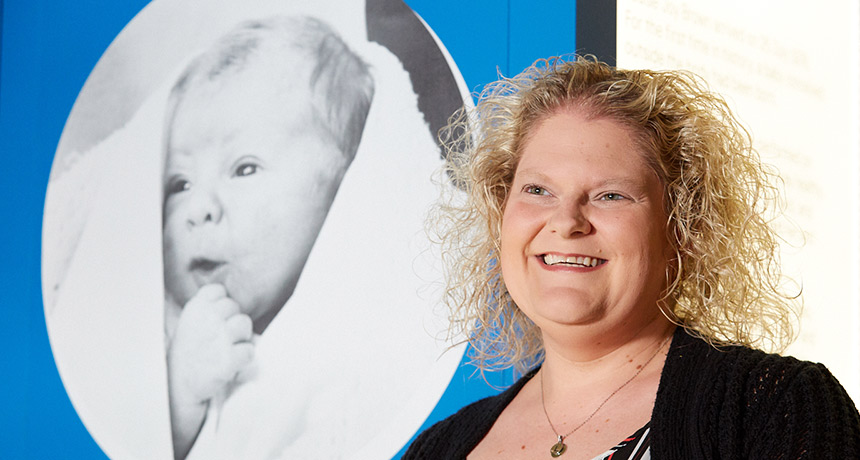40 years after the first IVF baby, a look back at the birth of a new era

Born on July 25, 1978, Louise Brown, shown here at the Science Museum in London next to her baby picture, was the first baby conceived with IVF. Today, the procedure has led to the birth of millions of babies.
© Science Museum, Jody Kingzett
- More than 2 years ago
At 11:47 p.m. on July 25, 1978, a baby girl was born by cesarean section at the Royal Oldham Hospital in England. This part of her arrival was much like many other babies’ births: 10 fingers and 10 toes, 5 pounds, 12 ounces of screaming, perfect newborn. Her parents named her Louise. But this isn’t the most interesting part about Louise’s origins. For that, you have to go back to November 12, 1977, also near midnight. That’s when Louise Joy Brown was conceived in a petri dish.
Louise was the first baby born as a result of in vitro fertilization, or IVF, a procedure that unites sperm and egg outside of the body. Her birth was heralded around the world, with headlines declaring that the first test-tube baby had been born. The announcement was met with excitement from some, fear and hostility from others. But one thing was certain: This was truly the beginning of a new era in how babies are created.
To celebrate Louise’s 40th birthday, I took at look at IVF’s origins, its present form and its future. IVF’s story starts around 1890, when scientist Walter Heape transferred a fertilized egg from an Angora rabbit into a different breed, and saw that Angora bunnies resulted.
Scientists soon began to work on other animals before turning eventually to humans. A fascinating account of the early days, written by IVF pioneer Simon Fishel in the July issue of Fertility and Sterility, recounts some of the more lively — and shocking — aspects of the nascent field. For example, IVF researcher Robert Edwards, who won a 2010 Nobel Prize for his work, used to carry eggs between labs in Oldham and Cambridge in a container strapped to his body. And some of the early experiments involved inseminating the eggs with the researchers’ own sperm. There was a steep learning curve that led to many failures: More than 300 women had oocytes, or egg cells, removed without success before Louise was conceived.
Bu then things turned around. On November 9, Lesley Brown began to ovulate (naturally, since the researchers hadn’t had success using hormones to stimulate ovulation in many women). The next day, researchers saw that her left ovary contained a single follicle, the structure that holds an oocyte. Along with the surrounding fluid, that follicle was aspirated and carried by a nurse to another researcher and then finally to Edwards, who was waiting at a microscope. The egg was fertilized with sperm and allowed to mature into an 8-cell embryo. At midnight on the 12th, it was ready for the fateful transfer back to Lesley.
From there, the research took off, often with dicey funding and public outcry. Along with colleague Patrick Steptoe, Edwards and other pioneers opened the first private IVF clinic in 1980. Today, clinics exist worldwide. That brings us to more modern numbers. In 2016 in the United States, an estimated 76,930 babies were born via assisted reproductive technologies. The vast majority of those babies were born via IVF. Over the past decade, assisted reproductive technology birth rates have doubled over the past decade, the CDC estimates. Today, about 1.7 percent of all babies born in the United States each year are conceived via the technology. Worldwide, millions of babies have been born with IVF.
The method has been hugely successful in helping families who otherwise wouldn’t be able to have children. And overall, the procedure has a good safety record. A study of Israeli teenagers born via IVF, for instance, didn’t turn up any problems when the teens were compared with those conceived the old-fashioned way. The teenagers all had comparable mental health, physical health and brainpower, researchers reported in 2017 in Fertility and Sterility.
But that doesn’t mean the technology will stay in its current form forever. Evolving biological capabilities might one day lead to better genetic screenings of embryos before they are implanted. And genetic tweaks might one day be possible, given the rapid rise of gene editing technology. Already, scientists have repaired a gene related to a heart defect in human embryos.
Other improvements might come too, such as making it easier on women to produce eggs for extraction. Less extreme hormone regimens might one day become more standard. With advances in stem cell technology, eggs may no longer be needed at all. Scientists may one day be able to coax skin cells into gametes. Scientists have already turned mouse skin cells into eggs and combined them with sperm to produce pups.
As I mull over the past and present of IVF, I’m amazed at how much progress has been made, both in labs and in clinics, and I suspect that the most exciting advances are yet to come. I also think about all of these well-loved babies, born to families destined to treasure them for the masterpieces of biology that they are.







